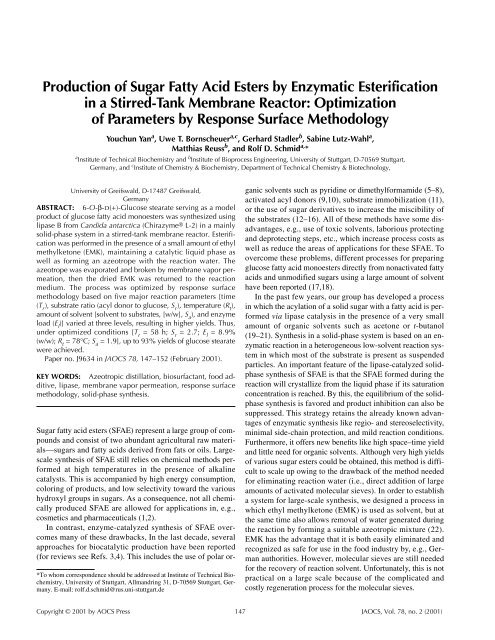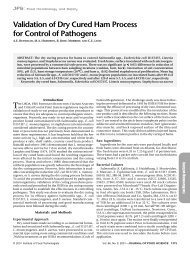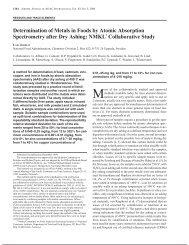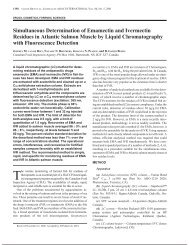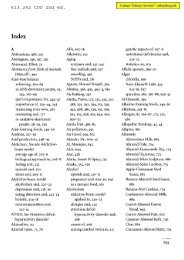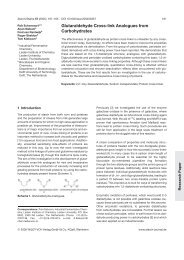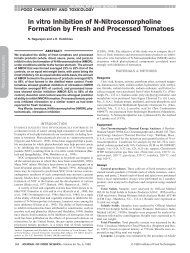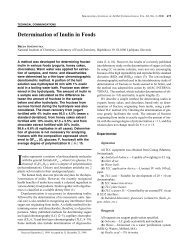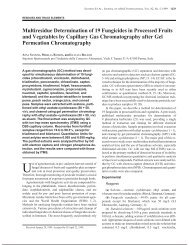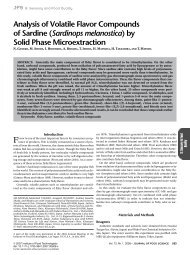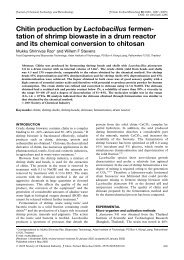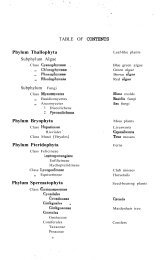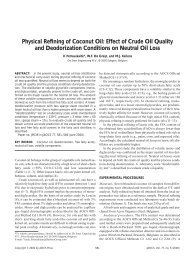Production of Sugar Fatty Acid Esters by Enzymatic
Production of Sugar Fatty Acid Esters by Enzymatic
Production of Sugar Fatty Acid Esters by Enzymatic
You also want an ePaper? Increase the reach of your titles
YUMPU automatically turns print PDFs into web optimized ePapers that Google loves.
<strong>Production</strong> <strong>of</strong> <strong>Sugar</strong> <strong>Fatty</strong> <strong>Acid</strong> <strong>Esters</strong> <strong>by</strong> <strong>Enzymatic</strong> Esterification<br />
in a Stirred-Tank Membrane Reactor: Optimization<br />
<strong>of</strong> Parameters <strong>by</strong> Response Surface Methodology<br />
Youchun Yana , Uwe T. Bornscheuera,c , Gerhard Stadlerb , Sabine Lutz-Wahla ,<br />
Matthias Reussb , and Rolf D. Schmida, *<br />
a b<br />
Institute <strong>of</strong> Technical Biochemistry and Institute <strong>of</strong> Bioprocess Engineering, University <strong>of</strong> Stuttgart, D-70569 Stuttgart,<br />
Germany, and c Institute <strong>of</strong> Chemistry & Biochemistry, Department <strong>of</strong> Technical Chemistry & Biotechnology,<br />
University <strong>of</strong> Greifswald, D-17487 Greifswald,<br />
Germany<br />
ABSTRACT: 6-O-β-D(+)-Glucose stearate serving as a model<br />
product <strong>of</strong> glucose fatty acid monoesters was synthesized using<br />
lipase B from Candida antarctica (Chirazyme® L-2) in a mainly<br />
solid-phase system in a stirred-tank membrane reactor. Esterification<br />
was performed in the presence <strong>of</strong> a small amount <strong>of</strong> ethyl<br />
methylketone (EMK), maintaining a catalytic liquid phase as<br />
well as forming an azeotrope with the reaction water. The<br />
azeotrope was evaporated and broken <strong>by</strong> membrane vapor permeation,<br />
then the dried EMK was returned to the reaction<br />
medium. The process was optimized <strong>by</strong> response surface<br />
methodology based on five major reaction parameters [time<br />
(T r ), substrate ratio (acyl donor to glucose, S r ), temperature (R t ),<br />
amount <strong>of</strong> solvent [solvent to substrates, [w/w], S a ), and enzyme<br />
load (E l )] varied at three levels, resulting in higher yields. Thus,<br />
under optimized conditions [T r = 58 h; S r = 2.7; E l = 8.9%<br />
(w/w); R t = 78°C; S a = 1.9], up to 93% yields <strong>of</strong> glucose stearate<br />
were achieved.<br />
Paper no. J9634 in JAOCS 78, 147–152 (February 2001).<br />
KEY WORDS: Azeotropic distillation, biosurfactant, food additive,<br />
lipase, membrane vapor permeation, response surface<br />
methodology, solid-phase synthesis.<br />
<strong>Sugar</strong> fatty acid esters (SFAE) represent a large group <strong>of</strong> compounds<br />
and consist <strong>of</strong> two abundant agricultural raw materials—sugars<br />
and fatty acids derived from fats or oils. Largescale<br />
synthesis <strong>of</strong> SFAE still relies on chemical methods performed<br />
at high temperatures in the presence <strong>of</strong> alkaline<br />
catalysts. This is accompanied <strong>by</strong> high energy consumption,<br />
coloring <strong>of</strong> products, and low selectivity toward the various<br />
hydroxyl groups in sugars. As a consequence, not all chemically<br />
produced SFAE are allowed for applications in, e.g.,<br />
cosmetics and pharmaceuticals (1,2).<br />
In contrast, enzyme-catalyzed synthesis <strong>of</strong> SFAE overcomes<br />
many <strong>of</strong> these drawbacks, In the last decade, several<br />
approaches for biocatalytic production have been reported<br />
(for reviews see Refs. 3,4). This includes the use <strong>of</strong> polar or-<br />
*To whom correspondence should be addressed at Institute <strong>of</strong> Technical Biochemistry,<br />
University <strong>of</strong> Stuttgart, Allmandring 31, D-70569 Stuttgart, Germany.<br />
E-mail: rolf.d.schmid@rus.uni-stuttgart.de<br />
ganic solvents such as pyridine or dimethylformamide (5–8),<br />
activated acyl donors (9,10), substrate immobilization (11),<br />
or the use <strong>of</strong> sugar derivatives to increase the miscibility <strong>of</strong><br />
the substrates (12–16). All <strong>of</strong> these methods have some disadvantages,<br />
e.g., use <strong>of</strong> toxic solvents, laborious protecting<br />
and deprotecting steps, etc., which increase process costs as<br />
well as reduce the areas <strong>of</strong> applications for these SFAE. To<br />
overcome these problems, different processes for preparing<br />
glucose fatty acid monoesters directly from nonactivated fatty<br />
acids and unmodified sugars using a large amount <strong>of</strong> solvent<br />
have been reported (17,18).<br />
In the past few years, our group has developed a process<br />
in which the acylation <strong>of</strong> a solid sugar with a fatty acid is performed<br />
via lipase catalysis in the presence <strong>of</strong> a very small<br />
amount <strong>of</strong> organic solvents such as acetone or t-butanol<br />
(19–21). Synthesis in a solid-phase system is based on an enzymatic<br />
reaction in a heterogeneous low-solvent reaction system<br />
in which most <strong>of</strong> the substrate is present as suspended<br />
particles. An important feature <strong>of</strong> the lipase-catalyzed solidphase<br />
synthesis <strong>of</strong> SFAE is that the SFAE formed during the<br />
reaction will crystallize from the liquid phase if its saturation<br />
concentration is reached. By this, the equilibrium <strong>of</strong> the solidphase<br />
synthesis is favored and product inhibition can also be<br />
suppressed. This strategy retains the already known advantages<br />
<strong>of</strong> enzymatic synthesis like regio- and stereoselectivity,<br />
minimal side-chain protection, and mild reaction conditions.<br />
Furthermore, it <strong>of</strong>fers new benefits like high space–time yield<br />
and little need for organic solvents. Although very high yields<br />
<strong>of</strong> various sugar esters could be obtained, this method is difficult<br />
to scale up owing to the drawback <strong>of</strong> the method needed<br />
for eliminating reaction water (i.e., direct addition <strong>of</strong> large<br />
amounts <strong>of</strong> activated molecular sieves). In order to establish<br />
a system for large-scale synthesis, we designed a process in<br />
which ethyl methylketone (EMK) is used as solvent, but at<br />
the same time also allows removal <strong>of</strong> water generated during<br />
the reaction <strong>by</strong> forming a suitable azeotropic mixture (22).<br />
EMK has the advantage that it is both easily eliminated and<br />
recognized as safe for use in the food industry <strong>by</strong>, e.g., German<br />
authorities. However, molecular sieves are still needed<br />
for the recovery <strong>of</strong> reaction solvent. Unfortunately, this is not<br />
practical on a large scale because <strong>of</strong> the complicated and<br />
costly regeneration process for the molecular sieves.<br />
Copyright © 2001 <strong>by</strong> AOCS Press 147 JAOCS, Vol. 78, no. 2 (2001)
148 Y. YAN ET AL.<br />
More recently, there has been interest in using pervaporation<br />
or vapor permeation membrane separation techniques for<br />
the selective separation <strong>of</strong> organic solvent mixtures because<br />
<strong>of</strong> their high separation efficiency and flux rates coupled with<br />
potential savings in energy costs (34). This technique depends<br />
on the fact that certain membranes permit easier passage <strong>of</strong><br />
one fluid than the other, thus changing the composition <strong>of</strong> the<br />
mixture through the permeate-selective, nonporous membrane.<br />
In this paper, we describe an integrated process that also<br />
allows separation <strong>of</strong> water from the azeotropic mixture <strong>by</strong> a<br />
vapor permeation membrane module, thus eliminating the requirement<br />
for molecular sieves. We chose a batch process for<br />
the synthesis <strong>of</strong> sugar esters because the market demands only<br />
small amounts <strong>of</strong> various kinds <strong>of</strong> SFAE, resulting in a higher<br />
production flexibility. Owing to the various parameters to be<br />
considered, we used response surface methodology (RSM) to<br />
identify the best process conditions. RSM has been successfully<br />
applied in many areas such as food processing (23), enzymatic<br />
synthesis <strong>of</strong> n-butyl glycoside (24), and enzymatic<br />
modification <strong>of</strong> fats and oils (25–27). A procedure with good<br />
prospects for the food industry is herein proposed and optimized<br />
for the production <strong>of</strong> SFAE.<br />
MATERIALS AND METHODS<br />
Enzyme, membrane, and chemicals. Chirazyme® L-2 (EC<br />
3.1.1.3, immobilized lipase B from Candida antarctica) was<br />
a gift from Roche Diagnostics GmbH (Penzberg, Germany).<br />
The Pervap® 2200 membrane was a donation from Sulzer<br />
Chemtech GmbH (Neunkirchen, Germany). Stearic acid was<br />
provided <strong>by</strong> Henkel KGaA (Düsseldorf, Germany). All other<br />
chemicals were purchased from Fluka (Buchs, Switzerland).<br />
Apparatus. A diagram <strong>of</strong> the apparatus is shown in<br />
Figure 1. A membrane reactor (top part suitable for a membrane<br />
with an area <strong>of</strong> 23 cm2 : i.d. 58 mm, height 2 mm, bottom<br />
part suitable for the enzymatic reaction: i.d. 20 mm ×<br />
height 7 mm) was provided <strong>by</strong> the Jülich Forschung GmbH<br />
(Jülich, Germany). The Pervap® 2200 membrane was soaked<br />
sequentially with water, acetone, and EMK before use. The<br />
temperature <strong>of</strong> the membrane reactor was maintained <strong>by</strong> circulating<br />
heated water from a water bath. Before starting the<br />
FIG. 1. Schematic diagram <strong>of</strong> lipase-catalyzed esterification for the production<br />
<strong>of</strong> sugar fatty acid esters in a stirred-tank membrane reactor. (1)<br />
Membrane reactor, (2) permeate condenser, (3) vacuum pump. TIC,<br />
temperature measurement; M, mixer; EMK, ethyl methylketone.<br />
JAOCS, Vol. 78, no. 2 (2001)<br />
reaction, the permeate container was cooled to −8°C <strong>by</strong> a<br />
thermostat and connected to a pump maintaining a vacuum <strong>of</strong><br />
99% (data not shown).<br />
HPLC analysis. All reaction mixtures and products were<br />
analyzed <strong>by</strong> an HPLC system equipped with a light-scattering<br />
mass detector and a Nucleosil 120-5C 18 column. The elution<br />
was carried out isocratically at 1 mL/min using methanol<br />
(70%), acetonitrile (25%), and water (5%) as a mobile phase<br />
for glucose palmitate and glucose stearate. For analysis <strong>of</strong><br />
glucose caprylate, a mobile phase <strong>of</strong> methanol/acetonitrile/<br />
water (50:30:20) was used.<br />
Experimental design. The experiments consisted <strong>of</strong> 29<br />
runs with five partial factors, each in three levels according to<br />
the central composite face design (28,29). According to our<br />
earlier works (19,20,22), the following parameters were investigated:<br />
time (T r , h), substrate ratio (S r , acyl donor to glucose,<br />
mol/mol), temperature (R t , °C), amount <strong>of</strong> EMK [S a ,<br />
solvent to substrates, (w/w)], and enzyme load [E l , % (w/w)<br />
<strong>of</strong> substrates]. Set ranges are listed in Table 1.<br />
Statistical analysis. Modde 4.0 (Umetri, Umeå, Sweden)<br />
was used to analyze the experimental data. Second-order coefficients<br />
were generated <strong>by</strong> regression analysis with backward<br />
elimination. Responses were first fitted for the five fac-
TABLE 1<br />
Set Factor Levels, Measured Responses, and the Comparison<br />
Between the Calculated Net Incorporation and the Predicted<br />
Results <strong>by</strong> the RSM-Fitted Modela Exp. Run<br />
Factors Conversion* (%)<br />
no. no. Tr Sr El Rt Sa Exp. Pr.<br />
1 5 24 1 6 74.5 2.5 52.3 52.3<br />
2 26 60 1 6 74.5 0.5 64 63.7<br />
3 3 24 3 6 74.5 0.5 52.8 52.9<br />
4 27 60 3 6 74.5 2.5 82.3 82.2<br />
5 21 24 1 12 74.5 0.5 57.8 58<br />
6 23 60 1 12 74.5 2.5 73.4 73.4<br />
7 4 24 3 12 74.5 2.5 69.2 69.6<br />
8 25 60 3 12 74.5 0.5 83.2 83.2<br />
9 24 24 1 6 78.5 0.5 46.3 46.1<br />
10 14 60 1 6 78.5 2.5 83.3 83<br />
11 16 24 3 6 78.5 2.5 67.6 67.7<br />
12 2 60 3 6 78.5 0.5 75.8 75.5<br />
13 17 24 1 12 78.5 2.5 63.5 63.7<br />
14 18 60 1 12 78.5 0.5 76 75.8<br />
15 29 24 3 12 78.5 0.5 63.9 64.1<br />
16 19 60 3 12 78.5 2.5 85 85<br />
17 22 24 2 9 76.5 1.5 72.9 72<br />
18 20 60 2 9 76.5 1.5 89.5 90.5<br />
19 13 42 1 9 76.5 1.5 80.3 80.8<br />
20 10 42 3 9 76.5 1.5 89.2 88.8<br />
21 6 42 2 6 76.5 1.5 78.6 79.4<br />
22 9 42 2 12 76.5 1.5 86.4 85.6<br />
23 1 42 2 9 74.5 1.5 84.6 84.2<br />
24 8 42 2 9 78.5 1.5 87 87.4<br />
25 15 42 2 9 76.5 0.5 76.8 77.2<br />
26 7 42 2 9 76.5 2.5 84.7 84.4<br />
27 28 42 2 9 76.5 1.5 87 86.7<br />
28 11 42 2 9 76.5 1.5 86.5 86.7<br />
29 12 42 2 9 76.5 1.5 86.8 86.7<br />
aTr , reaction time (24–60 h); Sr , acyl donor to glucose molar ratio (1–3); El ,<br />
enzyme load [6–12%, (w/w), <strong>of</strong> substrates]; Rt , reaction temperature<br />
(74.5–78.5°C); Sa , solvent (ethyl methylketone) amount (0.5–2.5-fold <strong>of</strong> substrates);<br />
Exp., experiment; Pr., prediction. Conversion* as referred to glucose.<br />
Experiments were run in run number. RSM, response surface methodology.<br />
tors <strong>by</strong> multiple regression. The fit <strong>of</strong> the model was evaluated<br />
<strong>by</strong> the coefficients <strong>of</strong> determination (R 2 —the fraction <strong>of</strong> the<br />
variation <strong>of</strong> the response explained <strong>by</strong> the model, an overestimated<br />
measure <strong>of</strong> the goodness <strong>of</strong> fit <strong>of</strong> the model; and Q 2 —<br />
the fraction <strong>of</strong> the variation <strong>of</strong> the response predicted <strong>by</strong> the<br />
model, an underestimated measure <strong>of</strong> the goodness <strong>of</strong> fit <strong>of</strong> the<br />
model) and analysis <strong>of</strong> variance (ANOVA). The insignificant<br />
coefficients were eliminated after examining coefficients, and<br />
the model was finally refined. The polynomial equation to be<br />
fitted to the measured, dependent variables Y was <strong>of</strong> the form:<br />
5<br />
5<br />
4<br />
Y = β + ∑βiXi + ∑βiiX<br />
2<br />
0<br />
i + ∑<br />
5<br />
∑βij<br />
XiXj i=<br />
1 i=<br />
1 i=<br />
1 j= i=<br />
1<br />
where Y is the value <strong>of</strong> the response, X i and X j are the independent<br />
variables, β 0 is the intercept, β i is the first-order<br />
model coefficients, β ii are the quadratic coefficients for the<br />
ith variable, and β ij are the interaction coefficients for the interaction<br />
<strong>of</strong> variables i and j.<br />
The performance <strong>of</strong> the enzymatic synthesis <strong>of</strong> SFAE was<br />
SUGAR FATTY ACID ESTER SYNTHESIS 149<br />
[1]<br />
evaluated <strong>by</strong> analyzing the response—conversion. Optimization<br />
<strong>of</strong> the reaction parameters was calculated using the predictive<br />
models from RSM. The synthesis <strong>of</strong> SFAE was carried<br />
out at the predicted optimal conditions. The observed response<br />
obtained at these conditions was analyzed and<br />
compared to the predicted value.<br />
RESULTS AND DISCUSSION<br />
In our previous publication (22), we could show that an efficient<br />
lipase-catalyzed synthesis <strong>of</strong> SFAE is possible <strong>by</strong> using<br />
a mainly solid-phase system. Further optimizations identified<br />
EMK as a suitable solvent, because it forms an azeotropic<br />
mixture with the water generated during the esterification.<br />
However, from a process point <strong>of</strong> view, continuous water removal<br />
without large consumption <strong>of</strong> solvent is desired. This<br />
can be achieved <strong>by</strong> using membranes that are highly selective<br />
for the removal <strong>of</strong> water from an organic solvent. To obtain<br />
high permeation rates and sufficient separations while maintaining<br />
high product yields, the reaction system was now optimized<br />
in detail as outlined in the following sections.<br />
Membrane selection. The choice <strong>of</strong> membrane material is<br />
crucial for a successful substrate conversion in this type <strong>of</strong> reactor.<br />
For dehydration <strong>of</strong> an organic solvent, hydrophilic<br />
polymers appear to be most suitable for the selective removal<br />
<strong>of</strong> the highly polar water (30–33). Preliminary investigations<br />
(data not shown) revealed that the water content <strong>of</strong> the enzymatic<br />
reaction mixture must be reduced to about 0.02–0.4%<br />
to ensure high concentrations <strong>of</strong> product. On the other hand,<br />
even at high conversions, the water content <strong>of</strong> EMK was<br />
rather low, in a range <strong>of</strong> 2–4% (vol/vol). Thus, the membrane<br />
must be very selective for water and should not allow permeation<br />
<strong>of</strong> EMK. These conditions were fulfilled <strong>by</strong> the Pervap®<br />
2200 membrane. The dehydration process can be divided into<br />
three steps: (i) water sorption into membrane at the upstream<br />
side, (ii) diffusion through the membrane, and (iii) water desorption<br />
into the vapor phase at the downstream side (34).<br />
The efficiency <strong>of</strong> the membrane is governed <strong>by</strong> the water concentration,<br />
the feed flow rate, pressure difference between upand<br />
downstream, and temperature. The water content is not<br />
constant during esterification and rises with increasing conversion.<br />
To ensure maximal water removal, we applied a vacuum<br />
<strong>of</strong>
150 Y. YAN ET AL.<br />
FIG. 2. Relationship between water content in EMK and water permeate<br />
at different temperature. Test condition: 20 mL EMK with 4.3–4.6%<br />
water, membrane module (Φ 58 × 8 mm, membrane area 23 cm 2 ), vacuum<br />
8–12 mbar (downstream), collection container −8°C, operating<br />
temperature (upstream) at 25, 40, 50, 60°C membrane at bottom <strong>of</strong><br />
module; at 75°C membrane at top <strong>of</strong> module. For abbreviation see Figure<br />
1.<br />
creased at temperatures above 60°C especially when the feed<br />
water content in the EMK was above 1.0%. For a technical<br />
application <strong>of</strong> the vapor permeation technology, the operating<br />
temperature should be taken as high as possible to achieve<br />
maximum permeation rates and to minimize the required<br />
membrane area and plant costs. On the other hand, the high<br />
optimal temperature <strong>of</strong> 75°C (above the boiling point <strong>of</strong> the<br />
azeotropic mixture) leads to low monoester formation due to<br />
the high solubility <strong>of</strong> the sugar fatty acid ester in the solvent,<br />
thus preventing the crystallization necessary for the shift <strong>of</strong><br />
the reaction equilibrium. As a consequence, synthesis <strong>of</strong><br />
sugar esters from medium-chain fatty acids should be performed<br />
in a normal stirred-tank reactor that is connected to a<br />
membrane module for dehydration, which then can be thermostated<br />
separately to appropriate temperatures.<br />
A series <strong>of</strong> experiments were carried out to investigate the<br />
esterification <strong>of</strong> glucose with stearic acid in a stirred-tank<br />
membrane reactor, in which the reaction water was removed<br />
<strong>by</strong> azeotropic distillation and the solvent was continuously dehydrated<br />
<strong>by</strong> membrane vapor permeation at 75°C. We found<br />
that at a stearic acid/glucose ratio <strong>of</strong> 1:1 (mol/mol), the conversions<br />
<strong>of</strong> monoesters were generally lower [75% for 6-O-β-<br />
D(+)-glucose-stearate] compared to our previous experiments<br />
(90%), which were performed at 60°C. Since a temperature<br />
around 75°C is a pre-condition for a successful azeotropic distillation,<br />
higher yields can only be obtained if all other reaction<br />
parameters (i.e., reaction time, substrate ratio, amount <strong>of</strong><br />
EMK, and enzyme load) are further optimized. Because <strong>of</strong> the<br />
complicated interaction <strong>of</strong> these parameters, we used RSM to<br />
identify the best reaction conditions.<br />
Optimization <strong>of</strong> the synthesis <strong>of</strong> glucose stearate as a<br />
model product <strong>by</strong> RSM. (i) Model fitting. By using the normalized<br />
results as the responses for the fitting <strong>of</strong> the RSM<br />
models, we could set up the quadratic relationships required<br />
for modeling. The ANOVA for the five process variables indicated<br />
that the SFAE yields can be well-described <strong>by</strong> a poly-<br />
JAOCS, Vol. 78, no. 2 (2001)<br />
nomial model. The second-order polynomials fitted to the<br />
measured data, which were computed <strong>by</strong> stepwise regression<br />
analysis using the standardized variables X i . Standardized<br />
values were used to attain proper preference between the variables<br />
in the calculation <strong>of</strong> the models. The data shown in<br />
Table 1 are, however, computed with those actual variables<br />
which also occur in the standardized models. The coefficient<br />
<strong>of</strong> determination (R 2 ) <strong>of</strong> the model for the response is 0.996<br />
(Q 2 = 0.899). According to the ANOVA, there was no lack <strong>of</strong><br />
fit, and there was a satisfactory coefficient <strong>of</strong> determination.<br />
Predicted results were close to the observed, and all absolute<br />
errors <strong>of</strong> the predictions were less than 1.0. This indicates that<br />
the model represents the real relationships between reaction<br />
parameters well.<br />
(ii) Main effects <strong>of</strong> parameters on responses. Optimization<br />
<strong>of</strong> the yield <strong>of</strong> glucose fatty acid monoester was performed<br />
<strong>by</strong> using the following parameters: reaction time,<br />
temperature, glucose/stearic acid molar ratio, solvent amount,<br />
and enzyme load. The yield <strong>of</strong> glucose fatty acid monoester<br />
was increased <strong>by</strong> longer reaction time, higher enzyme load,<br />
and higher substrate ratio. Reaction temperature had to be<br />
kept in a narrow range (between 74.5 and 78.5°C) in order to<br />
allow evaporation <strong>of</strong> the azeotrope and to change the gaseous<br />
EMK to a liquid when the azeotrope was broken. The different<br />
effects <strong>of</strong> the changing parameters are shown in Figure 3.<br />
From this, it can be observed that all five parameters had positive<br />
effects. The reaction time had significant influence on<br />
conversion for the first-order factors, which indicated longer<br />
reaction times were favored. For the second-order factors,<br />
solvent amount, reaction time, and enzyme load had negative<br />
effects on conversion. No significantly effective interactions<br />
in the model were observed, meaning that the production <strong>of</strong><br />
SFAE can be optimized <strong>by</strong> one-factor design.<br />
The merits <strong>of</strong> using RMS are to evaluate the relationships<br />
between each parameter and to predict the result and behavior<br />
under given reaction conditions. Moreover, optimal parameters<br />
can be obtained <strong>by</strong> iterative calculation with more than<br />
one response and targets. Optimization <strong>of</strong> the yield <strong>of</strong> glucose<br />
fatty acid monoester was performed <strong>by</strong> taking into account the<br />
FIG. 3. Main effects <strong>of</strong> the factors and their significance. T r , time (h); S a ,<br />
amount <strong>of</strong> EMK solvent/substrate (w/w); E l , enzyme load, % (w/w) <strong>of</strong><br />
substrates; S r , substrate ratio (acyl donor to glucose, mol/mol); R t , temperature<br />
(°C). For other abbreviation see Figure 1.
FIG. 4. Response surface plots for the evaluation <strong>of</strong> effects <strong>of</strong> parameters.<br />
Units: time (h); solvent amount, solvent to substrate ratio (w/w);<br />
enzyme load, % (w/w) <strong>of</strong> substrates; temperature (°C); conversion (%);<br />
substrate ratio (acyl donor to glucose, mol/mol).<br />
SUGAR FATTY ACID ESTER SYNTHESIS 151<br />
TABLE 2<br />
Optimum Conditions Generated <strong>by</strong> Modde 4.0 in the Set Parameter<br />
Ranges and Targets Through Iterative Calculation a<br />
Conversion (%)<br />
No. T r S r E l R t S a Pr. Exp. Iter.<br />
1 57.18 2.96 9.38 77.53 1.81 93.4 93.2 226<br />
2 57.35 2.80 9.02 78.18 1.86 93.6 93.5 136<br />
3 60.00 2.12 8.01 78.50 2.19 92.1 92.3 171<br />
4 58.02 2.72 8.89 78.27 1.86 93.5 93.5 129<br />
5 52.80 2.16 9.18 76.62 1.56 91.2 91.4 11<br />
6 60.00 2.40 9.00 76.50 1.50 91.7 91.8 0<br />
7 49.20 3.00 9.00 76.50 1.50 91.5 91.5 0<br />
8 49.20 2.00 9.00 78.50 1.70 91.1 91.0 7<br />
aSet parameter ranges: Tr , reaction time, 24–60 h; Sr , acyl donor to glucose<br />
molar ratio, 1–3 mol/mol; El , enzyme load, 6–12% w/w; Rt , reaction temperature,<br />
74.5–78.5°C; Sa , solvent (ethyl methylketone) amount, 0.5–2.5fold<br />
<strong>of</strong> substrates. Set targets: conversion 92.7% (minimum 88.2%). Pr., prediction;<br />
Exp., experiment; Iter., iteration.<br />
five parameters mentioned above. However, it should be noted<br />
that the range <strong>of</strong> each parameter has to be predecided before<br />
optimization, e.g., a shorter reaction time always results in<br />
lower conversion. On the other hand, shorter reaction times<br />
with a sufficient monoester yield allow for a higher space-time<br />
yield which is very important in terms <strong>of</strong> industrialization. To<br />
evaluate the relationships and interactions <strong>of</strong> parameters, surface<br />
plots give good prescriptions. The behavior <strong>of</strong> the product<br />
conversion under the process conditions is selectively presented<br />
in Figures 4 A–C. The optimization with one response<br />
and five variables cannot just be calculated mathematically<br />
through Equation 1 as more than one optimal condition may<br />
exist. Several optimal conditions have been proposed <strong>by</strong> RSM<br />
and are summarized in Table 2. It shows that optimal conditions<br />
are different and a conversion up to 93% can be achieved<br />
under the given reaction condition.<br />
To verify whether the predictive model could be applied to<br />
a preparative synthesis, eight experiments were carried out in<br />
a stirred-tank membrane reactor using the optimal conditions<br />
predicted <strong>by</strong> RSM. From the data shown in Table 2, it is obvious<br />
that predicted and experimental conversion match<br />
perfectly.<br />
ACKNOWLEDGMENTS<br />
We would like to thank Henkel KGaA (Düsseldorf, Germany),<br />
Roche Diagnostics GmbH (Penzberg, Germany), and Sulzer<br />
Chemtech GmbH (Neunkirchen, Germany) for providing us with<br />
chemicals, lipases, and membrane, respectively. Dr. Xuebing Xu,<br />
Technical University <strong>of</strong> Denmark, is appreciated for his useful suggestion.<br />
The award <strong>of</strong> the KAAD (Bonn, Germany) Graduate Fellowship<br />
to Mr. Youchun Yan is gratefully acknowledged.<br />
REFERENCES<br />
1. Fiechter, A., Biosurfactants: Moving Towards Industrial Application,<br />
Trends Biotechnol. 10:208–217 (1992).<br />
2. Hill, K., and O. Rhode, <strong>Sugar</strong>-Based Surfactants for Consumer<br />
Products and Technical Applications, Fett/Lipid 101:25–33<br />
(1999).<br />
JAOCS, Vol. 78, no. 2 (2001)
152 Y. YAN ET AL.<br />
3. Sarney, D.B., and E.N. Vulfson, Application <strong>of</strong> Enzymes to the<br />
Synthesis <strong>of</strong> Surfactants, Trends Biotechnol. 13:164–172<br />
(1995).<br />
4. Bornscheuer, U.T., and R.J. Kazlauskas, Hydrolases in Organic<br />
Synthesis—Regio- and Stereoselective Biotransformations,<br />
Wiley-VCH, Weinheim, 1999.<br />
5. Chopineau, J., F.D. McCafferty, M. Therisod, and A.M.<br />
Klibanov, <strong>Production</strong> <strong>of</strong> Biosurfactants from <strong>Sugar</strong> Alcohols<br />
and Vegetable Oils Catalyzed <strong>by</strong> Lipases in a Non-aqueous<br />
Medium, Biotechnol. Bioeng. 31:208–214 (1988).<br />
6. Riva, S., J. Chopineau, A.P.G. Kieboom, and A.M. Klibanov,<br />
Protease-Catalyzed Regioselective Esterification <strong>of</strong> <strong>Sugar</strong>s and<br />
Related Compounds in Anhydrous Dimethylformamide, J. Am.<br />
Chem. Soc. 110:584–589 (1988).<br />
7. Janssen, A.E.M., A.G. Lefferts, and K.V. Reit, <strong>Enzymatic</strong> Synthesis<br />
<strong>of</strong> Carbohydrate <strong>Esters</strong> in Aqueous Media, Biotechnol.<br />
Lett. 12:711–716 (1990).<br />
8. Janssen, A.E.M., C. Klabbers, M.C.R. Franssen, and K.V. Reit,<br />
<strong>Enzymatic</strong> Synthesis <strong>of</strong> Carbohydrate <strong>Esters</strong> in 2-Pyrrolidone,<br />
Enzyme Microb. Technol. 13:565–571 (1991).<br />
9. Therisod, M., and A.M. Klibanov, Facile <strong>Enzymatic</strong> Preparation<br />
<strong>of</strong> Monoacylated <strong>Sugar</strong>s in Pyridine, J. Am. Chem. Soc.<br />
108:5638–5640 (1986).<br />
10. Pulido, R., F.O. López, and V. Gotor, <strong>Enzymatic</strong> Regioselective<br />
Acylation <strong>of</strong> Hexoses and Pentoses Using Oxime <strong>Esters</strong>, J.<br />
Chem. Soc. Perkin Trans. 1:2981–2988 (1992).<br />
11. Sharma, A., and S. Chattopadhyay, Lipase Catalysed Acylation<br />
<strong>of</strong> Carbohydrates, Biotechnol. Lett. 15:1145–1193 (1993).<br />
12. Adelhorst, K., F. Björkling, S.E. Godtfredsen, and O. Kirk, Enzyme<br />
Catalysed Preparation <strong>of</strong> 6-O-Acylpyranosides, Synthesis<br />
2:112–115 (1990).<br />
13. Fregapane, G., D.B. Sarney, and E.N. Vulfson, <strong>Enzymatic</strong> Solvent-free<br />
Synthesis <strong>of</strong> <strong>Sugar</strong> Acetal <strong>Fatty</strong> <strong>Acid</strong> <strong>Esters</strong>, Enzyme<br />
Microb. Technol. 13:796–800 (1991).<br />
14. Fregapane, G., D.B. Sarney, and E.N. Vulfson, Facile Chemoenzymatic<br />
Synthesis <strong>of</strong> Monosaccharide <strong>Fatty</strong> <strong>Acid</strong> <strong>Esters</strong>, Biocatalysis<br />
11:9–18 (1994).<br />
15. Oguntimein, G.B., H. Erdmann, and R.D. Schmid, Lipase Catalyzed<br />
Synthesis <strong>of</strong> <strong>Sugar</strong> Ester in Organic Solvents, Biotechnol.<br />
Lett. 15:175–180 (1993).<br />
16. Schlotterbeck, A., S. Lang, V. Wray, and F. Wagner, Lipase-<br />
Catalyzed Monoacylation <strong>of</strong> Fructose, Ibid. 15:61–64 (1993).<br />
17. Ducret, A., A. Giroux, M. Trani, and R. Lortie, <strong>Enzymatic</strong><br />
Preparation <strong>of</strong> Biosurfactants from <strong>Sugar</strong>s or <strong>Sugar</strong> Alcohols<br />
and <strong>Fatty</strong> <strong>Acid</strong>s in Organic Media Under Reduced Pressure,<br />
Biotechnol. Bioeng. 48:214–221 (1995).<br />
18. Arcos, J.A., M. Bernabe, and C. Otero, Quantitative <strong>Enzymatic</strong><br />
<strong>Production</strong> <strong>of</strong> 6-O-Acylglucose esters, Ibid. 57:505–509 (1998).<br />
19. Cao, L., U.T. Bornscheuer, and R.D. Schmid, Lipase-Catalyzed<br />
Solid Phase Synthesis <strong>of</strong> <strong>Sugar</strong> <strong>Esters</strong>, Fat Sci. Technol. 98:<br />
332–335 (1996).<br />
JAOCS, Vol. 78, no. 2 (2001)<br />
20. Cao, L., A. Fisher, U.T. Bornscheuer, and R.D. Schmid, Lipase-<br />
Catalyzed Solid Phase Synthesis <strong>of</strong> <strong>Sugar</strong> <strong>Fatty</strong> <strong>Acid</strong> <strong>Esters</strong>,<br />
Biocatal. Biotransform. 14:269–283 (1996).<br />
21. Cao, L., U.T. Bornscheuer, and R.D. Schmid, Lipase-Catalyzed<br />
Solid-Phase Synthesis <strong>of</strong> <strong>Sugar</strong> <strong>Esters</strong>: Influence <strong>of</strong> Immobilization<br />
on Productivity and Stability <strong>of</strong> the Enzyme, J. Mol. Catal.<br />
B: <strong>Enzymatic</strong> 6:279–285 (1999).<br />
22. Yan, Y., U.T. Bornscheuer, L. Cao, and R.D. Schmid, Lipase-<br />
Catalyzed Solid Phase Synthesis <strong>of</strong> <strong>Sugar</strong> <strong>Fatty</strong> <strong>Acid</strong> <strong>Esters</strong>: Removal<br />
<strong>of</strong> By-Products <strong>by</strong> Azeotropic Distillation, Enzyme Microb.<br />
Technol. 25:725–728 (1999).<br />
23. Vainionpää, J., Modelling <strong>of</strong> Extrusion Cooking <strong>of</strong> Cereals<br />
Using Response Surface Methodology, J. Food Eng. 13:1–26<br />
(1991).<br />
24. Ismail, A., S. Soultani, and M. Ghoul, Optimization <strong>of</strong> the <strong>Enzymatic</strong><br />
Synthesis <strong>of</strong> Butyl Glucoside Using Response Surface<br />
Methodology, Biotechnol. Prog. 14:874–878 (1998).<br />
25. Xu, X., A.R.H. Skands, C.E. Høy, H. Mu, S. Balchen, and J.<br />
Adler-Nissen, <strong>Production</strong> <strong>of</strong> Specific-Structured Lipids <strong>by</strong> <strong>Enzymatic</strong><br />
Interesterification: Elucidation <strong>of</strong> Acyl Migration <strong>by</strong><br />
Response Surface Design, J. Am. Oil Chem. Soc. 75:1179–1186<br />
(1998).<br />
26. Xu, X., A.R.H. Skands, J. Adler-Nissen, and C.E. Høy, <strong>Production</strong><br />
<strong>of</strong> Specific-Structured Lipids <strong>by</strong> <strong>Enzymatic</strong> Interesterification:<br />
Optimization <strong>of</strong> the Reaction <strong>by</strong> Response Surface Design,<br />
Fett/Lipid 100:463–471 (1998).<br />
27. Xu, X., H. Mu, C.E. Høy, and J. Adler-Nissen, <strong>Production</strong> <strong>of</strong><br />
Specific-Structured Lipids <strong>by</strong> <strong>Enzymatic</strong> Interesterification in a<br />
Pilot Enzyme Bed Reactor: Process Optimization <strong>by</strong> Response<br />
Surface Methodology, Ibid. 101:207–214 (1999).<br />
28. MODDE for Windows: Statistical Modeling and Experimental<br />
Design, Graphical S<strong>of</strong>tware for Statistical Experimental Design<br />
(User’s Guide), Version 4.0, Umetri AB, Umea˚, 1997.<br />
29. Montagomery, D.C., Design and Analysis <strong>of</strong> Experiments, 4th<br />
edn., John Wiley & Sons Inc., New York, 1997.<br />
30. Van der Padt, A., J.J.W. Sewalt, and K.V. Riet, On-line Water<br />
Removal During <strong>Enzymatic</strong> Triacylglycerol Synthesis <strong>by</strong> Means<br />
<strong>of</strong> Pervaporation, J. Membrane Sci. 80:199–208 (1993).<br />
31. Ujang, Z., N.A. Sharbati, and A.M. Vaidya, Organic-Phase <strong>Enzymatic</strong><br />
Esterification in a Hollow Fiber Membrane Reactor<br />
with in situ Gas-Phase Water Activity Control, Biotechnol.<br />
Prog. 13:39–42 (1997).<br />
32. Napier, P.E., H.M. Lacerda, C.M. Rosell, R.H. Valivety, A.M.<br />
Vaidya, and P.J. Halling, Enhanced Organic-Phase <strong>Enzymatic</strong><br />
Esterification with Continuous Water Removal in a Controlled<br />
Air-Bleed Evacuated-Headspace Reactor, Ibid. 12:47–50<br />
(1996).<br />
33. Jirage, K.B., and C.R. Martin, New Developments in Membrane-Based<br />
Separations, Trends Biotechnol. 17:197–200<br />
(1999).<br />
34. Huang, R.Y.M., Pervaporation Membrane Separation
Processes, Elsevier, Amsterdam, 1991.<br />
[Received May 22, 2000; accepted September 28, 2000]<br />
SUGAR FATTY ACID ESTER SYNTHESIS 153<br />
JAOCS, Vol. 78, no. 2 (2001)


